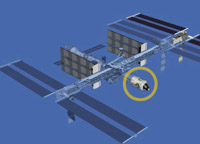NASA begins fueling Discovery

Despite bad weather forecasts for launch time NASA began fueling Discovery for liftoff Tuesday on a back-breakingly difficult space station construction mission.
The space shuttle was set to blast off at 11:38 a.m. local time (1538GMT). Fueling began as scheduled at 2:13 a.m. (0613GMT).
Meteorologists expected low rain clouds to move into the area by then and quite possibly to force a delay.
Hoping to beat the poor weather odds, NASA started pumping more than 500,000 gallons (1,892,650 liters) of super-cold liquid hydrogen and oxygen into Discovery's external tank, modified since the last mission to prevent dangerous ice buildup and reduce the potential for launch debris.
The wings, however, were not altered in any way, even though a safety engineering group pressed for a delay because of concern over three panels with possible flaws.
Commander Pamela Melroy, only the second woman to lead a shuttle mission, expressed her confidence late last week about flying Discovery, as have many of the senior managers who decided to skip wing repairs. A possible cracking problem with the protective coating on three of the wing panels was deemed an acceptably low risk.
A hole in the wing brought down Columbia in 2003.
Discovery and its crew of seven will embark on a two-week mission that is considered the most challenging and complex in the nine years of orbital assembly of the international space station.
The shuttle will carry up an Italian-built live-in compartment, about the size of a small bus, that the astronauts will attach to the space station. It is named Harmony, the choice of schoolchildren who took part in a national competition. Some of those youngsters traveled to Cape Canaveral to witness the launch.
Europe and Japan's laboratories will link up with Harmony once they are launched by shuttles over the next few months.
Discovery's astronauts also will move a massive girder and set of solar wings from one part of the space station to another. That work will involve extending radiators as well as the folded solar wings - 240 feet (73 meters) from tip to tip when outstretched.
In all, five spacewalks are planned, four to complete this construction job and one to test a method for fixing damaged shuttle thermal tiles using a caulking gun and high-tech goo. The demonstration with sample tiles was added after Endeavour suffered a gouge to its belly during the last launch in August from a piece of flyaway fuel-tank foam.
Once Discovery leaves, the three space station residents - one of whom will be dropped off by the shuttle - will face even more construction work to prepare for the European lab's arrival as early as December.
Discovery's crew includes an Italian astronaut making his first spaceflight, Paolo Nespoli.
Subscribe to Pravda.Ru Telegram channel, Facebook, RSS!


